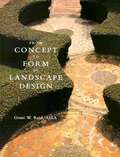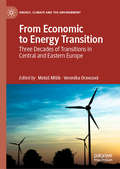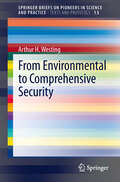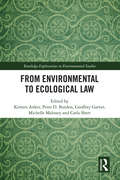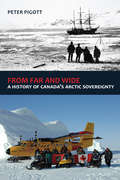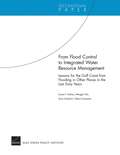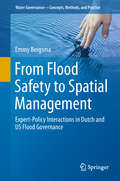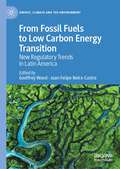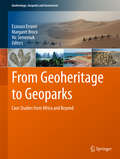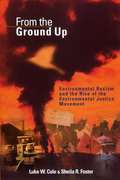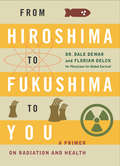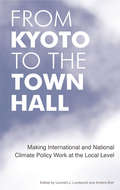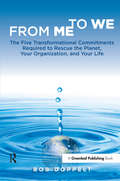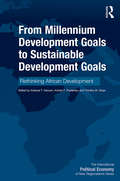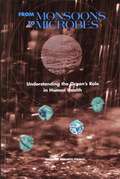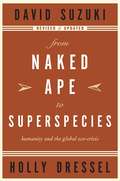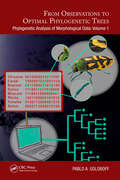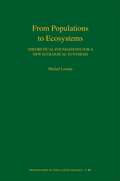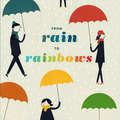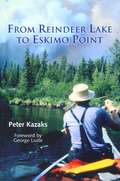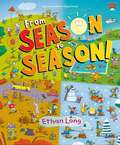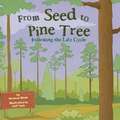- Table View
- List View
From Concept to Form in Landscape Design
by Grant W. ReidFrom Concept to Form in Landscape Design provides vital, functional techniques that make the transformation easier and more effective.
From Economic to Energy Transition: Three Decades of Transitions in Central and Eastern Europe (Energy, Climate and the Environment)
by Matúš Mišík Veronika OravcováThis book examines energy transition issues within the Central and Eastern European (CEE) region. The European Union is aiming for an almost complete decarbonization of its energy sector by 2050. However, the path towards a carbon-free economy is full of challenges that must be solved by individual EU members. Across 18 chapters, leading researchers explore challenges related to energy transition and analyse individual EU members from Central and Eastern Europe, as well as the region as a whole. To further explore this complex issue, the volume also includes several countries from South East Europe in its analysis. As perspective members, these countries will be important contributors to the EU’s mid- and long-term climate and energy goals. The focus on a variety of issues connected to energy transition and systematic analyses of the different CEE countries make it an ideal reference for anyone with a general interest in the region or European energy transition. It will also be a useful resource for students looking for an accessible overview of the field.
From Environmental to Comprehensive Security
by Arthur H. WestingThis work presents the evolution of the traditional concept of "national security" as military security to additionally embrace "environmental security" and then necessarily also "social (societal) security", thence to be termed "comprehensive human security". It accomplishes this primarily by presenting 11 of the author's own benchmark papers published between 1983 and 2010 (additionally providing bibliographic citations to a further 36 of the author's related publications during that period). The work stresses the importance of transfrontier (regional) cooperation, and also recognizes global overpopulation as a key impediment to achieving comprehensive human security.
From Environmental to Ecological Law (Routledge Explorations in Environmental Studies)
by Kirsten Anker; Peter D. Burdon; Geoffrey Garver; Michelle Maloney; Carla SbertThis book increases the visibility, clarity and understanding of ecological law. Ecological law is emerging as a field of law founded on systems thinking and the need to integrate ecological limits, such as planetary boundaries, into law. Presenting new thinking in the field, this book focuses on problem areas of contemporary law including environmental law, property law, trusts, legal theory and First Nations law and explains how ecological law provides solutions. Written by ecological law experts, it does this by 1) providing an overview of shortcomings of environmental law and other areas of contemporary law, 2) presenting specific examples of these shortcomings, 3) explaining what ecological law is and how it provides solutions to the shortcomings of contemporary law, and 4) showing how society can overcome some key challenges in the transition to ecological law. Drawing on a diverse range of case study examples including Indigenous law, ecological restoration and mining, this volume will be of great interest to students, scholars and policymakers of environmental and ecological law and governance, political science, environmental ethics and ecological and degrowth economics.
From Far and Wide: A History of Canada's Arctic Sovereignty
by Peter PigottIn the early 20th century the Canadian North was a mystery, but the Canadian military stepped in, and this book explores its historic activities in Canada’s Arctic. Is the Canadian North a state of mind or simply the lands and waters above the 60th parallel? In searching for the ill-fated Franklin Expedition in the 19th century, Britain’s Royal Navy mapped and charted most of the Arctic Archipelago. In 1874 Canadian Prime Minister Alexander Mackenzie agreed to take up sovereignty of all the Arctic, if only to keep the United States and Tsarist Russia out. But as the dominion expanded east and west, the North was forgotten. Besides a few industries, its potential was unknown. It was as one Canadian said for later. There wasn’t much need to send police or military expeditions to the North. Not only was there little tribal warfare between the Inuit or First Nations, but there were few white settlers to protect and the forts were mainly trading posts. Thus, in the early 20th century, Canada’s Arctic was less known than Sudan or South Africa. From Far and Wide recounts exclusively the historic activities of the Canadian military in Canada’s North.
From Flood Control to Integrated Water Resource Management
by Sara Hajiamiri Mengjie Wu James P. Kahan Debra KnopmanThe loss of life and devastation in the Gulf coast region of the United States after the hurricane season of 2005 has led to considerable debate about how to recover from the damage and mitigate damage from future incidents. This document reports the experiences of four major floods since 1948 (two in the United States, one in the Netherlands, and one in China), to draw lessons for the Gulf coast restoration effort.
From Flood Safety to Spatial Management: Expert-Policy Interactions in Dutch and US Flood Governance (Water Governance - Concepts, Methods, and Practice)
by Emmy BergsmaThis book deals with the introduction of a new type of “spatial measures" in flood governance. In contrast to traditional “safety measures" that aim to provide protection against floods by building structural flood defenses such as levees and flood walls, the goal of spatial measures is to reduce the exposure to flood risks by changing the spatial layout of flood-prone areas. By limiting developments and flood-proofing buildings in areas at risk to flooding, investments in structural flood defenses can be circumvented and vulnerabilities reduce. World-wide, spatial measures are gaining attractiveness as a response strategy to increasing flood risks caused by climate change and urbanization. The introduction of spatial measures in flood governance involves more than the simple development of new policies and laws. Research has demonstrated that the implementation of spatial measures can have huge implications for how costs and responsibilities are divided between different levels of governance and between public and private actors, changing the whole organization behind flood governance. Both for the effectiveness and for the legitimacy of spatial flood governance strategies, it is important that these distributive implications are well understood. This book describes the introduction of spatial measures in the context of two very different delta countries: the Netherlands and the United States. In the United States, a spatial flood governance strategy was already developed in de mid-20th century whereas in the Netherlands, a safety paradigm institutionalized over the course of the 20th century and spatial measures have only recently been introduced. By analyzing the science-policy interactions underlying the implementation of spatial measures in both countries, this book shows how under the influence of different types of experts (engineers in the Netherlands and social geographers in the United States) different spatial flood management strategies emerged with different distributive implications, each with its own challenges for effectiveness and legitimacy.
From Fossil Fuels to Low Carbon Energy Transition: New Regulatory Trends in Latin America (Energy, Climate and the Environment)
by Geoffrey Wood Juan Felipe Neira-CastroFocusing on five key themes - hydrocarbons, electricity, mining, social license to operate, and arbitration/dispute resolution- via in-depth country and regional case studies, this book seeks to capture the contrasting and sometimes conflicting trends in energy governance in Latin America as it wrestles with a dependence on fossil fuels whilst shifting toward a low carbon future. Energy transition continues to sit at the centre of the Latin American policy debate as the world continues to push for carbon neutrality by 2050. Latin America is undergoing a renewable energy transition, with substantial reserves (solar, wind, hydro, geothermal) and many countries in the region setting ambitious renewable energy policies, laws, and regulations to address climate change. However, recent initiatives to promote renewables must be placed in context. Historically, Latin America has developed and improved its economic and social standards due primarily to an economy based on the extractive industries and fossil fuels. This places renewables at the crossroads of multiple drivers, as the region seek to ensure security of supply, attract investment, and facilitate a low carbon energy transition.
From Geoheritage to Geoparks
by Ezzoura Errami Margaret Brocx Vic SemeniukThis unique book is dedicated to helping promote geoheritage, geoconservation, and geoparks in Africa and the Middle East. Local, regional, global and thematic case studies including a geoheritage toolkit are used to illustrate the scope and depth of geoheritage and highlight some current geoparks and aspiring candidates in Africa, the Middle East, China , Europe,and Australia. This special issue mainly consists of the proceedings of the First International Conference on Geoparks in Africa and Middle East (FICGAME) held in, El Jadida, Morocco in 2011. The conference, hosted by the Faculty of Sciences of Chouaib Doukkali University, was organized by the African Geoparks Network and the African Association of Women in Geosciences incollaboration with the UNESCO Cairo Office.
From The Ground Up: Environmental Racism and the Rise of the Environmental Justice Movement
by Luke W. Cole Sheila R. FosterWhen Bill Clinton signed an Executive Order on Environmental Justice in 1994, the phenomenon of environmental racism--the disproportionate impact of environmental hazards, particularly toxic waste dumps and polluting factories, on people of color and low-income communities--gained unprecedented recognition. Behind the President's signature, however, lies a remarkable tale of grassroots activism and political mobilization. Today, thousands of activists in hundreds of locales are fighting for their children, their communities, their quality of life, and their health. From the Ground Up critically examines one of the fastest growing social movements in the United States, the movement for environmental justice. Tracing the movement's roots, Luke Cole and Sheila Foster combine long-time activism with powerful storytelling to provide gripping case studies of communities across the U. S--towns like Kettleman City, California; Chester, Pennsylvania; and Dilkon, Arizona--and their struggles against corporate polluters. The authors effectively use social, economic and legal analysis to illustrate the historical and contemporary causes for environmental racism. Environmental justice struggles, they demonstrate, transform individuals, communities, institutions and even the nation as a whole.
From Hiroshima to Fukushima to You: A Primer on Radiation and Health
by Dale Dewar Florian OelckThe bombing of Hiroshima on August 6, 1945, brought radiation to international attention but the exact nature of what had been unleashed was still unclear to most. The 1986 meltdown at the Chernobyl nuclear plant again made headlines with estimates of fatalities ranging from 4000 to almost a million deaths. By the time of the shocking 2011 disaster at the Fukushima nuclear plant social media meant governments and corporations no longer had a monopoly over the release of information, but transparency remains low on the agenda. Meanwhile, few physicians give thought to the delayed health effects of radiation. It has been the bold physician who has challenged the potential overuse of chest X-rays, CT scanning, or PET scans. This book provides clear and accurate information about radiation so that we can all make informed choices. In clear language it offers answers to citizens’ questions: What is radiation? Where do we encounter it? What are the benefits and risks? How do we develop a responsible future around the uses and abuses of radioactivity?
From Kyoto to the Town Hall: Making International and National Climate Policy Work at the Local Level
by Lennart J. Lundqvist Anders BielInternational agreements such as the Kyoto Protocol, EU regulation and country-specific national climate policies offer some hope of addressing climate change. But all too often implementation of these high level objectives is derailed at the sub-national, local and - perhaps most important - individual level, by a variety of structural, policy and perceived barriers that result in a failure of effective action. Drawing on original research from Sweden, a world leader in effective environmental solutions, this volume examines the difficulties of aligning climate policy from international to national and sub-national levels. The authors address the full range of barriers and complexities, including governance structures, the relationship between 'experts' and the public, political feasibility, tax measures, perceptions of 'fairness' and self-interest, and the importance of environmental values. Also covered are the roles and perceptions of organizations and professions, the place of carbon-free technologies (such as wind power), the relationship between national and EU regulations, and the monumental challenge of governing the climate in a bordered and divided world. This volume is a vital source of information for all those seeking to create effective, coordinated responses to the challenge of climate change.
From Me to We: The Five Transformational Commitments Required to Rescue the Planet, Your Organization, and Your Life
by Bob DoppeltIn From Me to We: The Five Transformational Commitments Required to Rescue the Planet, Your Organization, and Your Life, systems change expert Bob Doppelt reveals that most people today live a dream world, controlled by false perceptions and beliefs. The most deeply held illusion is that all organisms on Earth, including each of us, exist as independent entities. At the most fundamental level, the change needed to overcome our misperceptions is a shift from focusing only on "me" – our personal needs and wants – to also prioritizing the broader "we": the many ecological and social relationships each of us are part of, those that make life possible and worthwhile. Research shows that by using the techniques described in this book this shift is possible – and not that difficult to achieve. From Me to We offers five transformational "commitments" that can help you change your perspective and engage in activities that will help resolve today's environmental and social problems. Not coincidentally, making these commitments can improve the quality of your life as well. Bob Doppelt's latest book is a wake-up call to the creed of individualism. He calls for recognition of the laws of interdependence, cause and effect, moral justice, trusteeship, and free will. The book will be essential to all of those interested in how we can create and stimulate a sea change in how to enable the necessary behavioral change we need to deal with the myriad environmental and social pressures consuming the planet.
From Millennium Development Goals to Sustainable Development Goals: Rethinking African Development (The International Political Economy of New Regionalisms Series)
by Kobena T. Hanson Korbla P. Puplampu Timothy M. ShawMillennium development goals (MDGs) and sustainable development goals (SDGs) have significant implications for global development, in particular for African countries. This book seeks to assist Africa’s policy makers and political leaders, MNCs and NGOs, plus its increasingly heterogeneous media landscape, to understand and better respond or negotiate the evolving development environment of the 21st century. In this collection of nuanced essays, the contributors interrogate the relationship between the MDGs and SDGs in key areas of African development to enhance our understanding and knowledge of the evolving nature of development. They address issues of governance, agriculture, south-south cooperation in a context of foreign aid, natural resource governance and sustainable development, export diversification and economic growth as well as emerging topics such as the internet of things or the sharing economy, climate change, conflict and non-traditional security. The varied, yet interlinked foci present a holistic overview of Africa’s development aspirations, and ability to transform the SDGs’ universal aspirations into local realities. This book will be of use to academics and students in Development Studies, Contemporary African Studies, Political Science, Policy Studies and Geography, and should also appeal to policy makers and development practitioners.
From Monsoons to Microbes: Understanding the Ocean's Role in Human Health
by National Research CouncilWhat can sharks teach us about our immune system? What can horseshoe crabs show us about eyesight?The more we learn about the ocean, the more we realize how critical these vast bodies of water are to our health and well-being. Sometimes the ocean helps us, as when a marine organism yields a new medical treatment. At other times, the ocean poses the threat of coastal storm surges or toxic algal blooms.From Monsoons to Microbes offers a deeper look into the oceans that surround us, often nuturing yet sometimes harming humankind. This book explores the links among physical oceanography, public health, epidemiology, marine biology, and medicine in understanding what the ocean has to offer. It will help readers grasp such important points as: How the ocean's sweeping physical processes create long-term phenomena such as El Nino and short-term disastrous events such as tsunamis--including what communities can do to prepare.What medicines and nutritional products have come from the ocean and what the prospects are for more such discoveries.How estuaries work--where salt and fresh water meet--and what can go wrong, as in the 7,000 square mile "dead zone" at the out-flow of the Mississippi River.How the growing demand for seafood and the expansion of ocean-going transport has increased our exposure to infectious agents--and how these agents can be tracked down and fought.Why "red tides" of toxic algae suddenly appear in previously unaffected coastal areas, and what happens when algal toxins find their way into our food supply or the air we breathe. The book recommends ways we can implement exciting new technologies to monitor the physics, chemistry, and biology of the ocean to recognize change as it happens. From the impact of worldwide atmospheric warming to the significance of exotic bacteria from submarine hydrothermal vents, the ocean has many depths left to explore.
From Naked Ape to Superspecies
by David Suzuki Holly DresselFor millennia, we lived in harmony with the Earth, taking only what we required to survive. But in just the past few centuries, we have used our powers to satisfy our obsession with consumption and new technology, without regard for the consequences. And in doing so, we have exploited our surroundings on an unprecedented scale. In this revised and updated edition of From Naked Ape to Superspecies, David Suzuki and Holly Dressel lucidly describe how we have evolved beyond our needs, trampling other species, believing that we can make the Earth work the way we want it to. And they introduce us to the people who are fighting back, those who are resisting the inexorable advance of the "global economy" juggernaut, the people whose voices are difficult to hear over the din of corporate public relations machines. We learn about how human arrogance-demonstrated by our disregard for the small and microscopic species that constitute the Earth's engine and our reckless use of technological inventions like powerful herbicides or genetically engineered crops-is threatening the health of our children and the safety of our food supply.
From Observations to Optimal Phylogenetic Trees: Phylogenetic Analysis of Morphological Data: Volume 1 (Species and Systematics)
by Pablo A. GoloboffTaxonomists specializing in different groups once based phylogenetic analysis only on morphological data; molecular data was used more rarely. Although molecular systematics is routine today, the use of morphological data continues to be important, especially for phylogenetic placement of many taxa known only from fossils and rare or difficult to collect species. In addition, morphological analyses help identify potential biases in molecular analyses. And finally, scenarios with respect to morphology continue to motivate biologists: the beauty of a cheetah or a baobab does not lie in their DNA sequence, but instead on what they are and do! This book is an up-to-date revision of methods and principles of phylogenetic analysis of morphological data. It is also a general guide for using the computer program TNT in the analysis of such data. The book covers the main aspects of phylogenetic analysis and general methods to compare classifications derived from molecules and morphology. The basic aspects of molecular analysis are covered only as needed to highlight the differences with methods and assumptions for analysis of morphological datasets.
From Populations to Ecosystems: Theoretical Foundations for a New Ecological Synthesis (MPB-46) (Monographs in Population Biology #46)
by Michel LoreauThe major subdisciplines of ecology--population ecology, community ecology, ecosystem ecology, and evolutionary ecology--have diverged increasingly in recent decades. What is critically needed today is an integrated, real-world approach to ecology that reflects the interdependency of biodiversity and ecosystem functioning. From Populations to Ecosystems proposes an innovative theoretical synthesis that will enable us to advance our fundamental understanding of ecological systems and help us to respond to today's emerging global ecological crisis. Michel Loreau begins by explaining how the principles of population dynamics and ecosystem functioning can be merged. He then addresses key issues in the study of biodiversity and ecosystems, such as functional complementarity, food webs, stability and complexity, material cycling, and metacommunities. Loreau describes the most recent theoretical advances that link the properties of individual populations to the aggregate properties of communities, and the properties of functional groups or trophic levels to the functioning of whole ecosystems, placing special emphasis on the relationship between biodiversity and ecosystem functioning. Finally, he turns his attention to the controversial issue of the evolution of entire ecosystems and their properties, laying the theoretical foundations for a genuine evolutionary ecosystem ecology. From Populations to Ecosystems points the way to a much-needed synthesis in ecology, one that offers a fuller understanding of ecosystem processes in the natural world.
From Rain to Rainbows
by Chronicle BooksThis sweet and modern little ebook proves that after the rain always comes the rainbow. A treasure trove of delightful work by beloved indie art stars and emerging talents, this cheering collection echoes the uplifting transformation of rain into rainbows: the book begins with raindrops and umbrellas, transitions midway through, and concludes with a glorious bouquet of colorful rainbows. Perfect for bringing smiles to anyone who needs a little pick-me-up, this ebook of feel-good art is a reminder to appreciate the dark with the light, because nothing stays the same forever—and things are about to look a whole lot brighter.
From Reindeer Lake to Eskimo Point
by Peter Kazaks George LusteCanoe across large lakes, up and down rivers and rapids; labour over portages and through a miasma of blackflies; bask in the golden evenings of the Subarctic. In this account of an 800-mile canoe trip – which begins at Reindeer Lake on the Manitoba/Saskatchewan border, continues into Nunavut past the treeline, and ends on Hudson Bay – Peter Kazaks conveys the experience of being in the north by describing the daily details that bring the trip to life. He captures the flavour of an extended wilderness canoe trip and reflects on living in unfettered wilderness. The reader will also grasp something of the serene beauty of the barren lands and begin to understand why its intoxicating nature keeps drawing some back. The first half of the trip, essentially from Reindeer Lake to Nueltin Lake, retraces P.G. Downes’ voyage described in his classic Sleeping Island. Next the four men of this expedition, led by George Luste, entered the barren lands and followed the Thlewiaza River, the Kognak River, South Henik Lake and the Maguse River north and east to the shore of Hudson Bay. These lands, seldom visited, are close to a true wilderness – one of the few remaining ones.
From Resource Scarcity to Ecological Security: Exploring New Limits to Growth
by Dennis Pirages Ken CousinsA new recognition of profound interconnections between social and natural systems is challenging conventional constructs and the policy predispositions informed by them. Our current intellectual challenge is to develop the analytical and theoretical underpinnings of an understanding of the relationship between the social and the natural systems. Our policy challenge is to identify and implement effective decision-making approaches to managing the global environment.
From Rocky Waters to a Smooth Finish: Neal Petersen's Story (Fountas & Pinnell LLI Purple #Level S)
by Helen ScullyBorn dark-skinned in South Africa and with a missing hip joint, Neal Petersen faced many challenges to achieve his dream of sailing around the world.
From Season to Season: Happy County Book 4 (Happy County #4)
by Ethan LongEthan Long’s From Season to Season is the fourth book in the Happy County preschool picture book series featuring earth science and educational activities about winter, spring, summer, and fall. For readers who love Richard Scarry’s Busytown books.Adventure awaits in another exciting trip through Happy County—where each new season packs plenty of surprises! Farmer Dell rides his tractor through the crops all summer long; Jimmy and Sammy search for Grammy Tammy in the autumn corn maze; Dolly and Molly build an igloo with the fresh winter snow; and Miss Humdiddy’s flower garden buzzes with pollination when spring arrives. This primer compendium is filled with lovable characters and educational content connected to weather, geography, earth science, word identifications, as well as the concepts of shapes, patterns, telling time, and grammar—all delivered through plenty of clever scenarios to keep little ones engaged and curious. Christy Ottaviano Books
From Seed to Pine Tree: Following the Life Cycle (Into Reading, Read Aloud Module 8 #1)
by Suzanne Slade Jeff YeshNIMAC-sourced textbook
From Seed to Plant
by Gail GibbonsExplores the intricate relationship between seeds and the plants which they produce. [This text is listed as an example that meets Common Core Standards in English language arts in grades 2-3 at http://www.corestandards.org.]
